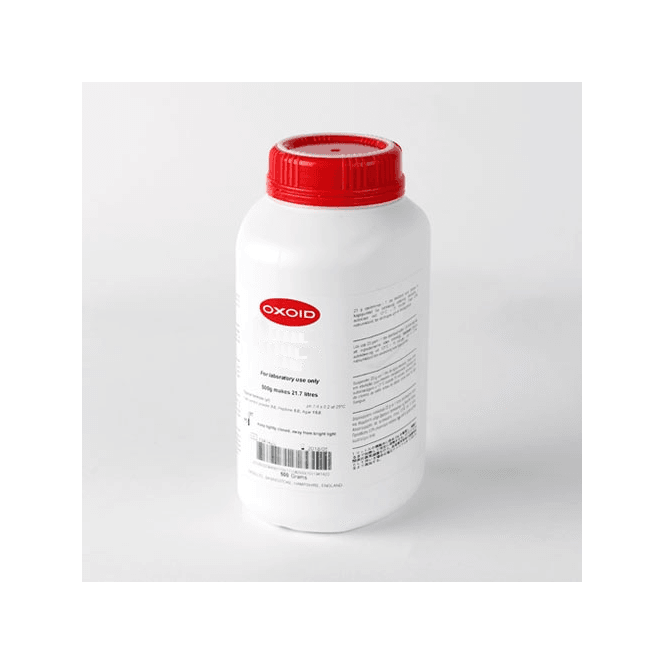Thermo Scientific™ Oxoid™ Eosin Methylene Blue Agar (Modified) Levine (Dehydrated)
Catalog No :
CAS Number :
Brand :
In Stock
Specifications:
| Application | Microbiology | ||
| Storage Temperature | Ambient | ||
| Product Type | Culture Medium | Forms | Powder |
| Product Brand | Thermo Fisher Scientific™, Oxoid | ||
| Product Grade | Microbiology grade | Formula | For 13.3L medium |
The Thermo Scientific™ Oxoid™ Eosin Methylene Blue Agar (Modified) (Levine) (Dehydrated) is a versatile differential medium designed for the isolation, enumeration, and differentiation of Enterobacteriaceae, particularly Escherichia coli and Enterobacter aerogenes. Conforming to the formula specified by the American Public Health Association (APHA), this medium also supports the rapid identification of Candida albicans when modified with chlortetracycline hydrochloride.
Key Features
- Differentiation of Coliforms:
- E. coli forms purple colonies with a green metallic sheen, while Enterobacter aerogenes produces purple mucoid colonies.
- APHA-Recommended:
- Endorsed for coliform detection and differentiation in food, water, and clinical samples.
- Versatile Applications:
- Suitable for identifying Candida albicans in clinical specimens when supplemented with chlortetracycline hydrochloride.
- Rapid Results:
- Provides clear differentiation of lactose-fermenting and non-lactose-fermenting organisms.
- Broad Utility:
- Effective for testing food, environmental, and clinical samples.
Applications
1. Clinical Microbiology
- Differentiation of Escherichia coli and Enterobacter aerogenes from fecal and other clinical specimens.
- Rapid identification of Candida albicans from clinical materials when supplemented.
2. Food and Environmental Microbiology
- Detection and differentiation of Enterobacteriaceae in food samples such as dairy, meat, and beverages.
- Monitoring coliform contamination in environmental samples and water.
3. Water Quality Testing
- Enumeration of coliforms and E. coli in potable water and wastewater as specified by APHA guidelines.
Specifications
| Attribute | Details |
|---|---|
| Product Type | Agar |
| Form | Powder |
| Description | Eosin Methylene Blue Agar (Modified) (Levine) |
| Applications | Clinical, food, environmental, and water microbiology |
| Quantity | 500g |
| Yield | 13.3L of prepared medium |
| Compliance | APHA |
Preparation Instructions
- Suspend: Suspend 37g of Eosin Methylene Blue Agar (Modified) (Levine) in 1 liter of distilled water.
- Mix and Heat: Heat with frequent agitation to dissolve completely. Do not autoclave.
- Cool and Dispense: Cool the medium to 45–50°C, pour into sterile Petri dishes, and allow to solidify.
- Supplement for Candida: If detecting Candida albicans, add chlortetracycline hydrochloride as per the protocol.
Advantages
- Clear Differentiation: Provides distinct colony appearances for E. coli, Enterobacter aerogenes, and non-lactose fermenters.
- Wide Application Range: Suitable for clinical, food, water, and environmental testing.
- Reliable Performance: Conforms to APHA guidelines for coliform detection and differentiation.
- Cost-Effective: High yield of 13.3L per 500g, making it economical for routine testing.
Diagnostic Features
| Organism | Colony Appearance |
|---|---|
| E. coli | Purple colonies with green metallic sheen |
| Enterobacter aerogenes | Purple mucoid colonies |
| Non-Lactose Fermenters | Colorless or pale colonies |
| Candida albicans | Requires supplementation for identification |
Storage and Stability
- Storage: Store the dehydrated medium at 10–30°C in a dry environment.
- Shelf Life: Refer to product label for expiration date.
Packaging
- Product: Eosin Methylene Blue Agar (Modified) (Levine) (Dehydrated)
- Quantity: 500g
- Yield: 13.3L of prepared medium
The Thermo Scientific™ Oxoid™ Eosin Methylene Blue Agar (Modified) (Levine) (Dehydrated) is a reliable and efficient medium for differentiating coliforms, including E. coli and Enterobacter aerogenes, in clinical, food, water, and environmental samples. Its versatility, compliance with APHA guidelines, and ability to support additional diagnostic applications like Candida albicans identification make it an essential tool for microbiology laboratories.




 0
0
